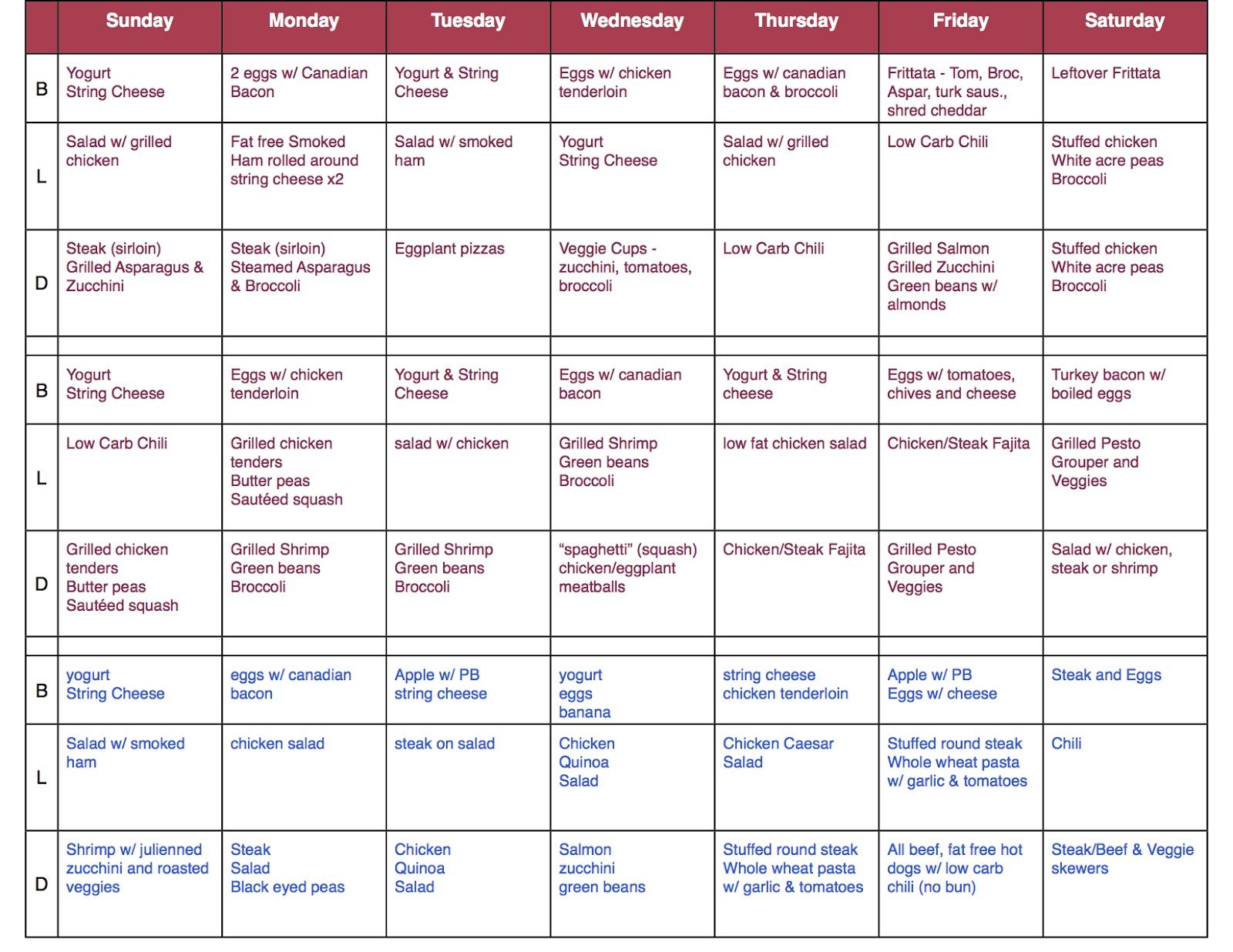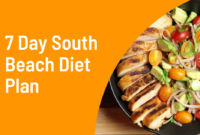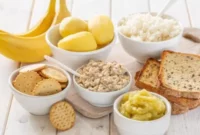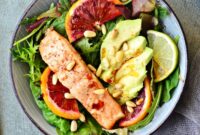South Beach Diet Phase 3 marks a significant transition in the weight-loss journey. This phase focuses on maintaining the weight loss achieved in the previous stages while gradually reintroducing a wider variety of foods. It emphasizes sustainable healthy eating habits, ensuring long-term success and avoiding the common pitfalls of restrictive diets. Understanding the principles of Phase 3, including permitted foods, portion control, and exercise recommendations, is crucial for achieving and maintaining a healthy weight.
This guide delves into the specifics of South Beach Diet Phase 3, providing a detailed breakdown of its core components. We’ll explore the macronutrient distribution, address potential nutrient deficiencies, and offer practical strategies for overcoming common challenges. Furthermore, we will outline a plan for transitioning into a sustainable maintenance phase, ensuring lasting results and improved overall health.
Overview of South Beach Diet Phase 3
Phase 3 of the South Beach Diet marks the transition to a long-term, sustainable lifestyle. It’s not a strict diet phase but rather a flexible approach to maintaining your weight loss and incorporating a wider variety of foods while still adhering to the core principles of the diet. This phase emphasizes mindful eating and portion control to prevent weight regain.
Core Principles of Phase 3
The core principles of Phase 3 focus on maintaining a balanced diet rich in lean protein, healthy fats, and complex carbohydrates while limiting processed foods, sugary drinks, and unhealthy fats. This approach supports sustained weight management by promoting satiety, stabilizing blood sugar levels, and providing the body with essential nutrients. The emphasis shifts from strict restriction to mindful food choices and portion control. This phase allows for greater flexibility in food choices while still maintaining healthy eating habits.
Permitted Foods and Portion Sizes
Phase 3 allows for a wider variety of foods compared to the previous phases. Lean proteins like fish, poultry, beans, and tofu remain central. Healthy fats such as avocados, nuts, and olive oil are encouraged. A broader range of fruits and vegetables are permitted, including higher-glycemic-index fruits in moderation. Whole grains, such as brown rice and quinoa, are also included. Portion sizes are individualized based on caloric needs, activity levels, and individual metabolic rates. However, the general guideline remains mindful eating and avoiding overconsumption. A registered dietitian or nutritionist can help determine appropriate portion sizes for individual needs.
Rationale Behind Dietary Restrictions
The continued limitation of processed foods, sugary drinks, and unhealthy fats in Phase 3 is crucial for long-term health and weight maintenance. Processed foods often contain high levels of unhealthy fats, added sugars, and sodium, which can contribute to weight gain, inflammation, and various health problems. Sugary drinks provide empty calories with little nutritional value, leading to increased calorie intake without satiety. Unhealthy fats, such as saturated and trans fats, raise cholesterol levels and increase the risk of heart disease. By minimizing these foods, the South Beach Diet aims to promote sustained weight loss and overall well-being.
Sample Meal Plan for a Typical Day in Phase 3
The following is a sample meal plan; individual needs may vary. Calorie counts are estimates and can fluctuate based on specific food choices and portion sizes.
| Meal | Food Item | Quantity | Calories (approx.) |
|---|---|---|---|
| Breakfast | Oatmeal with berries and nuts | 1 cup oatmeal, ½ cup berries, ¼ cup nuts | 350 |
| Lunch | Grilled chicken salad with mixed greens and avocado | 4 oz chicken, 2 cups greens, ½ avocado | 400 |
| Dinner | Baked salmon with roasted vegetables | 4 oz salmon, 1 cup roasted vegetables | 450 |
| Snack | Greek yogurt with fruit | 1 cup yogurt, ½ cup fruit | 150 |
Nutrient Profile of Phase 3
South Beach Diet Phase 3 marks a transition towards a more sustainable, long-term eating pattern. Unlike the initial restrictive phases, Phase 3 emphasizes the incorporation of a wider variety of foods while maintaining a focus on healthy fats, lean proteins, and controlled carbohydrate intake. Understanding the nutrient profile of this phase is crucial for maximizing its benefits and avoiding potential pitfalls.
The macronutrient distribution in a typical Phase 3 diet prioritizes a balance. While precise ratios vary depending on individual caloric needs and activity levels, a general guideline might include approximately 40-50% of calories from carbohydrates, 20-30% from protein, and 30-40% from healthy fats. This differs significantly from many other weight-loss diets that severely restrict certain macronutrients. The carbohydrates are predominantly from whole grains, fruits, and vegetables, offering fiber and essential nutrients. Protein sources encompass lean meats, fish, poultry, legumes, and dairy. Healthy fats are derived from sources like avocados, nuts, seeds, and olive oil.
Potential Vitamin and Mineral Deficiencies and Mitigation Strategies
Restricting certain food groups, even in a balanced diet like Phase 3, carries the risk of nutritional deficiencies. For example, a diet overly focused on specific protein sources might lack sufficient intake of certain vitamins and minerals. Potential deficiencies could include vitamin B12 (if vegetarian or vegan options are heavily emphasized), iron (if red meat consumption is significantly reduced), and calcium (if dairy intake is limited). To mitigate these risks, careful meal planning and potential supplementation are essential. A multivitamin tailored to individual needs, combined with incorporating a variety of nutrient-rich foods, can help ensure adequate micronutrient intake. For instance, including leafy greens alongside lean proteins can boost iron levels, and incorporating fortified foods can address potential vitamin B12 deficiencies in those avoiding animal products.
Comparison to Other Weight Loss Diets
Compared to very low-carbohydrate diets like keto, Phase 3 allows for a more moderate carbohydrate intake. This approach aims to promote sustained weight loss without the potential side effects associated with extremely restrictive diets, such as keto flu or nutrient deficiencies. Unlike some fad diets that rely on rapid weight loss through extreme calorie restriction, Phase 3 focuses on building healthier eating habits for long-term weight management. Furthermore, in contrast to diets that severely limit whole food groups, Phase 3 encourages the inclusion of a wider range of healthy foods, leading to a more varied and nutritious diet. For example, unlike some diets that completely eliminate certain food groups like fruits, Phase 3 incorporates them in moderation, contributing to a balanced nutrient profile.
Impact on Blood Sugar Levels and Insulin Sensitivity
The balanced macronutrient distribution of Phase 3, with a focus on complex carbohydrates, lean protein, and healthy fats, is designed to positively impact blood sugar levels and insulin sensitivity. The emphasis on fiber-rich foods helps slow down glucose absorption, preventing sharp spikes in blood sugar. The adequate protein intake aids in stabilizing blood sugar levels by promoting satiety and slowing down gastric emptying. Furthermore, the inclusion of healthy fats contributes to improved insulin sensitivity. This approach contrasts with diets high in processed carbohydrates and refined sugars, which can lead to significant blood sugar fluctuations and insulin resistance. Studies have shown that diets similar to Phase 3 can improve glucose tolerance and insulin sensitivity in individuals with pre-diabetes or type 2 diabetes. For instance, a study published in the American Journal of Clinical Nutrition showed improvements in glycemic control among participants following a moderate carbohydrate, high-fiber diet.
Exercise Recommendations During Phase 3
Phase 3 of the South Beach Diet marks a transition to a more sustainable lifestyle, incorporating regular exercise to maintain weight loss and improve overall health. This phase emphasizes building strength and endurance, complementing the dietary changes already implemented. The goal is to create a balanced fitness routine that supports your long-term well-being.
Sample Weekly Exercise Plan
A well-rounded exercise plan should include both cardiovascular activity and strength training. The following sample plan provides a guideline, adaptable to individual fitness levels and preferences. Remember to consult your physician before starting any new exercise program.
This plan balances cardio and strength training, ensuring a comprehensive approach to fitness. It prioritizes consistency over intensity, particularly during the initial weeks of implementation.
| Day | Activity | Duration/Sets/Reps |
|---|---|---|
| Monday | Cardio (brisk walking, jogging, cycling) | 30 minutes |
| Tuesday | Strength Training (full body) | 3 sets of 10-12 repetitions for each exercise (e.g., squats, push-ups, lunges, rows) |
| Wednesday | Rest or Active Recovery (yoga, stretching) | 30 minutes |
| Thursday | Cardio (swimming, elliptical training) | 30-45 minutes |
| Friday | Strength Training (upper body focus) | 3 sets of 10-12 repetitions for each exercise (e.g., bicep curls, tricep extensions, shoulder presses) |
| Saturday | Active Rest (hiking, light sport) | 60 minutes |
| Sunday | Rest or Active Recovery | 30 minutes |
Workout Routine Complementing Phase 3 Dietary Restrictions
The exercises chosen should be appropriate for all fitness levels and should not put excessive strain on the body. The focus is on sustainable, long-term fitness rather than rapid, intense workouts.
This routine focuses on compound exercises, which work multiple muscle groups simultaneously, maximizing calorie burn and efficiency. It also incorporates flexibility and recovery days to prevent injury and promote muscle growth.
Cardio and Strength Training Recommendations
Cardiovascular exercise helps burn calories, improve cardiovascular health, and boost metabolism. Strength training builds muscle mass, which increases metabolism and helps maintain a healthy weight. A combination of both is ideal for overall fitness. Examples of suitable cardio activities include brisk walking, jogging, swimming, cycling, and elliptical training. Strength training can involve bodyweight exercises (push-ups, squats, lunges) or weight training with dumbbells or resistance bands.
Hydration During Phase 3
Staying adequately hydrated is crucial for overall health and particularly important during weight management. Water helps regulate body temperature, aids digestion, and supports various bodily functions. Aim for at least 8 glasses of water per day, adjusting the intake based on activity levels and individual needs. Consider adding electrolyte-rich beverages, such as coconut water or diluted sports drinks, after intense workouts to replenish lost electrolytes. Dehydration can mimic hunger, leading to increased food intake. Maintaining adequate hydration helps prevent this.
Potential Challenges and Solutions in Phase 3
South Beach Diet Phase 3, while a step towards long-term healthy eating, can present some unique challenges. Maintaining the balanced approach of this phase requires consistent effort and a proactive strategy to overcome potential hurdles. Understanding these challenges and implementing effective solutions is key to successfully navigating this final stage and achieving sustainable weight management.
Common Difficulties Encountered During Phase 3
Individuals transitioning to Phase 3 often experience a shift in their dietary habits, leading to potential difficulties. These can range from managing cravings for previously restricted foods to navigating social situations where dietary choices are limited. Successfully managing these challenges will depend on planning and implementing effective coping mechanisms.
Strategies for Overcoming Challenges in Phase 3
Successfully navigating Phase 3 necessitates a proactive approach to managing cravings and adapting to social situations. Careful planning and the implementation of various coping strategies are crucial for long-term success.
- Meal Prepping: Preparing meals and snacks in advance helps to ensure you always have healthy, Phase 3-compliant options readily available. This minimizes the temptation to reach for less healthy choices when hunger strikes or time is limited. For example, preparing a large batch of chicken salad or vegetable stir-fry can provide multiple healthy lunches throughout the week.
- Craving Management: Identify your common cravings and develop strategies to address them. This might involve substituting unhealthy cravings with healthy alternatives. For example, if you crave sweets, try a small portion of dark chocolate or berries. Keeping a food journal can help pinpoint triggers and patterns.
- Social Situation Strategies: Social gatherings can present challenges. Plan ahead by checking menus beforehand and choosing healthy options. If there aren’t suitable choices, bring a healthy dish to share. Don’t be afraid to politely explain your dietary needs to your host or friends. Focus on enjoying the company, not just the food.
- Mindful Eating: Pay attention to your hunger and fullness cues. Eat slowly and savor your food. This can help prevent overeating and increase satisfaction with smaller portions. Practice mindful eating techniques like putting your fork down between bites.
- Stress Management: Stress can often lead to unhealthy eating habits. Incorporate stress-reducing activities like exercise, yoga, or meditation into your routine. These practices can help regulate hormones and reduce emotional eating.
Seeking Professional Guidance
While the strategies outlined above are helpful, it’s important to remember that individual needs vary. If you’re struggling to maintain Phase 3 or experiencing significant challenges, seeking guidance from a registered dietitian or healthcare professional is crucial. They can provide personalized advice and support tailored to your specific needs and circumstances. A professional can also help identify any underlying health conditions that may be impacting your weight loss journey.
Long-Term Sustainability of Phase 3
Successfully completing Phase 3 of the South Beach Diet marks a significant achievement, but maintaining your weight loss and reaping the long-term health benefits requires a thoughtful transition to a sustainable lifestyle. This isn’t about reverting to old habits; it’s about integrating the healthy principles you’ve learned into your daily life.
The transition from Phase 3 to a maintenance phase isn’t a sudden switch but a gradual adjustment. Think of it as a slow curve rather than a sharp turn. You’ll gradually reintroduce more carbohydrates, but with a focus on healthy, whole grains and fiber-rich options, while continuing to prioritize lean proteins and healthy fats. The key is mindful eating and portion control, preventing a rapid return to previous dietary patterns.
Transitioning from Phase 3 to Maintenance
The transition involves slowly increasing your carbohydrate intake while remaining mindful of portion sizes and food quality. Start by adding small portions of healthy carbohydrates, like whole-grain bread or brown rice, one or two times a week. Observe how your body responds. If you experience weight gain, reduce the amount or frequency of these additions. The goal is to find a balance that allows you to maintain your weight loss without feeling deprived. Regular monitoring of your weight and body measurements will provide valuable feedback.
Tips for Maintaining Weight Loss After Phase 3
Maintaining weight loss after completing Phase 3 requires a holistic approach that incorporates dietary adjustments, regular physical activity, and mindful lifestyle choices. Consistent weighing, combined with tracking food intake and exercise, can help identify potential slip-ups and enable timely corrections.
Maintaining a healthy weight is not just about the food we eat; it’s also about our physical activity. Regular exercise, even if it’s just a brisk walk for 30 minutes most days, plays a crucial role in weight management and overall well-being. Additionally, stress management techniques, such as yoga or meditation, can indirectly contribute to weight maintenance by reducing emotional eating tendencies.
Long-Term Health Benefits of a Modified Phase 3 Diet
Adhering to a modified version of the Phase 3 diet long-term can lead to significant improvements in various health markers. For example, studies have shown that diets rich in fruits, vegetables, lean protein, and whole grains are associated with a reduced risk of heart disease, type 2 diabetes, and certain types of cancer. Maintaining a healthy weight also lowers the risk of developing osteoarthritis and other joint problems. The sustained reduction in inflammation, a common consequence of obesity, can also lead to improvements in overall health and well-being.
Visual Representation of the Transition
Imagine a graph. The Y-axis represents weight, and the X-axis represents time. The graph begins with a steep downward slope representing the weight loss during the three phases of the South Beach Diet. At the end of Phase 3, the slope gradually levels off, becoming almost horizontal, representing the maintenance phase. However, this horizontal line isn’t perfectly flat; it fluctuates slightly within a narrow range, reflecting the natural variations in weight. This visualization demonstrates the sustained weight loss and the transition to a stable, healthy weight.
Recipe Ideas for Phase 3
Phase 3 of the South Beach Diet allows for a wider variety of foods, including healthy fats and a slightly increased carbohydrate intake compared to the previous phases. These recipes focus on nutrient-dense ingredients while remaining within the dietary guidelines of Phase 3. Remember to adjust portion sizes to meet your individual caloric needs.
Mediterranean Salmon with Roasted Vegetables
This recipe provides a healthy balance of protein, healthy fats, and fiber, perfect for a Phase 3 dinner. The nutritional information is an approximation and may vary slightly based on specific ingredients and portion sizes.
- Ingredients:
- 1 (6-ounce) salmon fillet
- 1 cup broccoli florets
- 1/2 cup sliced bell peppers (any color)
- 1/4 cup chopped red onion
- 1 tablespoon olive oil
- 1 teaspoon dried oregano
- 1/2 teaspoon garlic powder
- Salt and pepper to taste
- Lemon wedges for serving (optional)
Instructions: Preheat oven to 400°F (200°C). Toss broccoli, bell peppers, and red onion with olive oil, oregano, garlic powder, salt, and pepper. Spread on a baking sheet. Place salmon fillet on the same baking sheet. Bake for 15-20 minutes, or until salmon is cooked through and vegetables are tender. Serve with lemon wedges, if desired.
Approximate Nutritional Information (per serving): Calories: Approximately 450-500; Protein: 35-40g; Fat: 25-30g; Carbohydrates: 10-15g
Chicken and Avocado Salad
This light and refreshing salad is a great option for lunch or a light dinner. The avocado provides healthy fats and creaminess, while the chicken offers lean protein.
- Ingredients:
- 4 ounces grilled chicken breast, diced
- 1/2 avocado, diced
- 1/2 cup cherry tomatoes, halved
- 1/4 cup chopped cucumber
- 2 tablespoons chopped red onion
- 1 tablespoon olive oil
- 1 tablespoon lime juice
- Salt and pepper to taste
- Mixed greens for serving (optional)
Instructions: Combine all ingredients in a bowl. Toss gently to combine. Serve over mixed greens, if desired.
Approximate Nutritional Information (per serving): Calories: Approximately 300-350; Protein: 30-35g; Fat: 15-20g; Carbohydrates: 10-15g
Shrimp Scampi with Zucchini Noodles
This low-carb alternative to traditional shrimp scampi uses zucchini noodles instead of pasta, making it a suitable Phase 3 option.
- Ingredients:
- 8 ounces shrimp, peeled and deveined
- 2 medium zucchini, spiralized into noodles
- 2 cloves garlic, minced
- 2 tablespoons olive oil
- 1/4 cup dry white wine (optional)
- 2 tablespoons lemon juice
- 1 tablespoon chopped fresh parsley
- Salt and pepper to taste
Instructions: Heat olive oil in a large skillet over medium heat. Add garlic and cook for 1 minute, until fragrant. Add shrimp and cook for 2-3 minutes per side, until pink and cooked through. If using, add white wine and cook for 1 minute, until slightly reduced. Stir in zucchini noodles, lemon juice, and parsley. Cook for 2-3 minutes, until zucchini is tender-crisp. Season with salt and pepper to taste.
Approximate Nutritional Information (per serving): Calories: Approximately 250-300; Protein: 25-30g; Fat: 10-15g; Carbohydrates: 5-10g
Conclusion
Successfully navigating South Beach Diet Phase 3 requires commitment and understanding. By adhering to the guidelines, focusing on balanced nutrition, and incorporating regular exercise, individuals can achieve and maintain a healthy weight. Remember, consistency and mindful eating are key to long-term success. This phase isn’t just about weight management; it’s about cultivating a healthier lifestyle that supports overall well-being. The transition to a maintenance phase is a crucial step, ensuring the hard work doesn’t go to waste. With careful planning and a focus on sustainable habits, the benefits of South Beach Diet Phase 3 can extend far beyond the initial weight loss goals.




